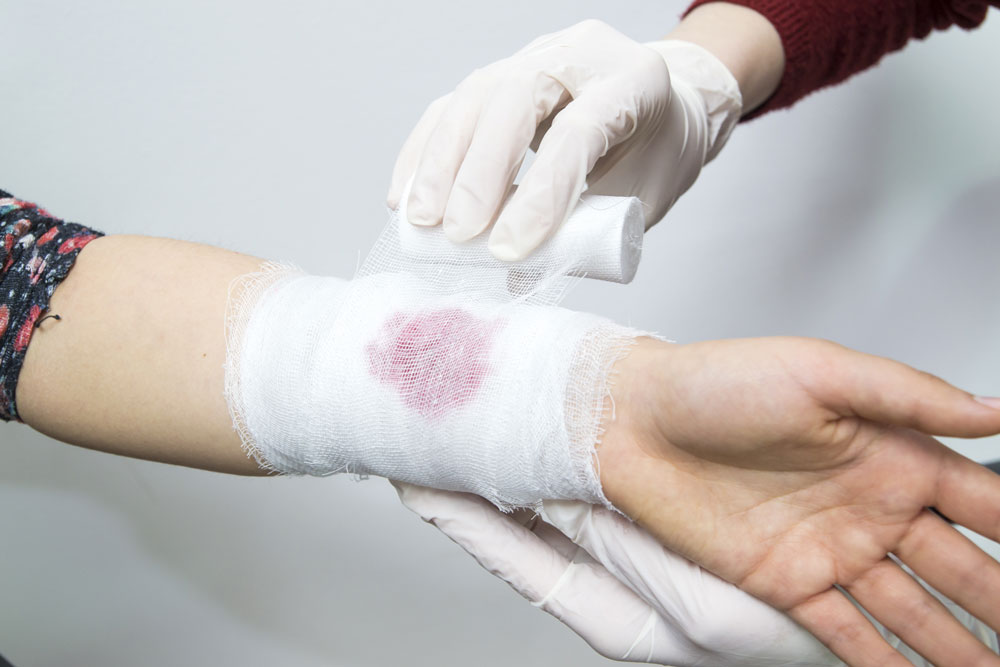The knowledge development in wound care is fast. Are you keeping up?
This article has been translated with AI and written based on Swedish conditions. Hopefully, it can inspire interested parties from other countries.
Wound care in elderly care is getting better and better. We see fewer and fewer nasty wounds, and wounds that do occur heal to a greater extent. Caring for hard-to-heal wounds requires patience, expertise, and a holistic perspective on the patient's health. Advances in wound care make it possible to offer more effective treatment and better quality of life for those affected by hard-to-heal wounds. It is important to follow the latest findings and best practices in the field to provide the best possible care for patients with hard-to-heal wounds.
 Foto: Mostphotos
Foto: MostphotosHard-To-Heal Wounds
Written with inspiration from RiksSår, Vårdhandboken, and lecture
https://www.youtube.com/watch?v=hqVT2WhbMRY
My experience and assessment is that wound care is a neglected area, we work with it as little as we do with incontinence materials. They often mean a great deal of suffering for the patient on several levels. Properly managed wound care reduces both suffering and costs.
Everyone who works in healthcare needs to be vigilant about risks for wounds and have knowledge that makes them understand when the risk increases. In addition, there need to be people who are skilled in getting skin damage and wounds to heal.
For a frail person, being bedridden for a whole weekend, for example in connection with fever, means an increased risk of pressure sores. Anti-decubitus mattresses and turning schedules may need to be implemented at short notice.
In the past, we talked about chronic wounds, but now we know that most wounds can heal with the right treatment. Wounds that do not heal within six weeks are now called hard-to-heal wounds. Hard-to-heal wounds primarily affect elderly people with multiple illnesses. Wound care must be conducted in teams. Today, it is easier to document in a simple way when we can take a picture which is more descriptive than formulating a text.
Antibiotics are prescribed unnecessarily. Wound registration in "RiksSår". A structured care of the patient with diagnosis, treatment strategy and follow-up of the patient leads to reduced use of antibiotics.
Residents who get wounds often have an underlying disease. Diabetic foot ulcers are often found on the foot soles. People with cardiovascular disease often get wounds on toes, foot dorsum or heel. Those with reduced mobility often get pressure sores and so on. Sometimes the resident takes medication that can impair healing and therefore needs to be taken into account in the treatment of the wound.
Lifestyle factors such as weight loss and smoking can also negatively affect wounds. Many patients also believe that they should not move much, but movement is good for both wound healing and appetite. The exception here is pressure sores and diabetic foot ulcers where relieving pressure is often important. If the patient is a smoker, quitting smoking is an important lifestyle choice to improve wound healing.
When planning wound care, therefore, many factors need to be included. Previous wounds, how the wound originated, where it is located are things that need to be included in the planning. Some wounds are painful and the resident may need help with pain relief as well.
Wound care needs to be handled inter-professionally and it is important that professional wound care also takes place during on-call hours. The nurse needs to cooperate with the occupational therapist, doctor, and physiotherapist when it comes to the treatment of the wound. Sometimes a dietitian can suggest a complementary treatment to the direct wound care. Referrals may also be needed to ensure diagnosis and get the best treatment.
Correct routines for handling wound care materials are also of great importance. A difficulty to consider is getting equivalent wound care materials when changing supplier.
Challenges and Advances in Wound Care
Healing hard-to-heal wounds can be a patience-testing and challenging task. It is important to always consider underlying contributory causes. Wound care often requires careful monitoring to avoid complications and promote healing.
Challenges with wound care:
Infection risk: Hard-to-heal wounds are more susceptible to infections due to their open nature. Infections can delay the healing process and lead to serious complications.
Pain and discomfort: Hard-to-heal wounds can be very painful and cause discomfort for the patient. Managing the pain is an important part of care.
Slow healing: Some wounds take a long time to heal, and it can be challenging to maintain patience and motivation for both the patient and the caregiver.
Underlying health problems: As the healing process is linked to the underlying factors, it is important to also have a well-functioning treatment for these.
Advances in wound care:
Modern wound care materials: Advances in materials science have led to the development of advanced wound care materials designed to promote healing and reduce the risk of infections. This includes antimicrobial bandages and other products with specific properties for different types of wounds.
Imaging technology: Improved imaging technology helps to diagnose underlying problems and create more precise treatment plans.
Multidisciplinary approach: Hard-to-heal wounds often require collaboration between different medical specialties. By cooperating across professional boundaries, we can accelerate the healing processes.
Patient education: Educating the patient about wound care and preventive measures is an important part of treatment. It helps the patient to actively participate in their own care and prevent recurring wounds.
Research and development: Ongoing research in the field of wound healing leads to constant improvements and new treatment methods.
Reflection questions - hard-to-heal wounds
Care staff:
- Do you have good routines for contacting the nurse when you discover skin redness or wounds?
- Do you have routines to notice if someone becomes bedridden and therefore has an increased risk of getting pressure sores?
- Do you get good instructions for handling skin care from the nurse?
Manager, nurse, occupational therapist, and physiotherapist:
- Do you have good team cooperation around wounds and wound care?
- Do you have recurring training around wounds?
- Do you create wound care journals together to get the best treatment of wounds?
- Is your doctor engaged in wound care?
- Are referrals written for consultation about hard-to-heal wounds?
- Do you keep statistics about your wound care?
Residents and relatives:
- Does your relative have any hard-to-heal wounds?
- Is there a wound care journal?
- Have you been asked questions about previous experiences with wounds?
Erland Olsson
Specialist nurse
Sofrosyne - Better care every day

Aktuellt i media
-
2025-12-18 04:00
16 Sjukdom och död
Survivor conversations - an important element in working with next of kin
info Bild från Summer Stock
Bild från Summer Stock - 2025-12-15 04:00 17 Psykisk hälsa
- 2025-12-11 04:00 07 Riskhantering
- 2025-12-08 04:00 06 Dokumentation
- 2025-12-03 04:00 06 Dokumentation
- 2025-12-01 04:00 02 Värdegrund






